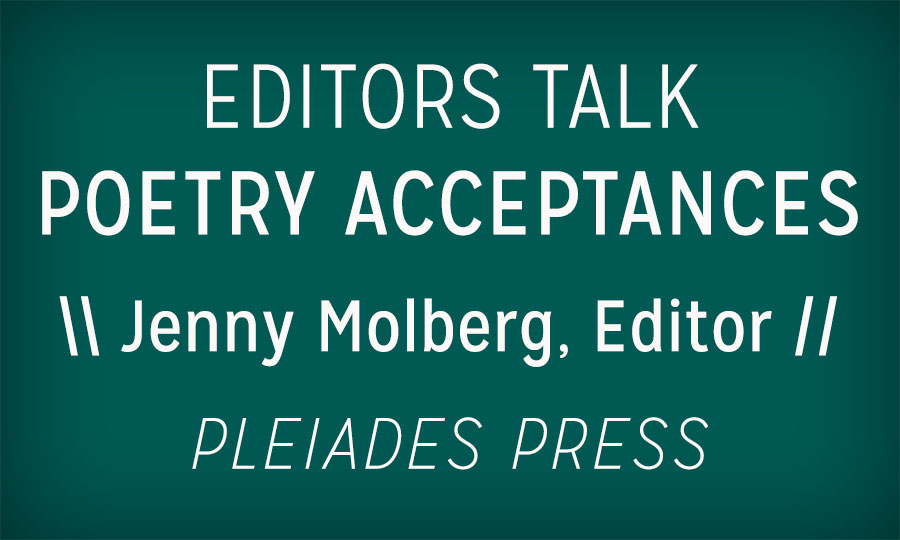Editors Talk Poetry Acceptances: Jenny Molberg, Pleiades

As a platform for emerging poets, our mission is to provide practical help for serious writers. The community lifts itself up together or not at all. In that light, we’ve been asking some great editors from around the literary community for their frank thoughts on why poems may get accepted/rejected from their own slush pile of submissions, and what poets can do to better their chances. Today, we’re speaking with Jenny Molberg, Co-Editor in Chief of Pleiades.
From a craft standpoint, what causes you to accept a poem?
Jenny Molberg: My co-editor, Erin Adair-Hodges, and I make the final poetry selections for Pleiades: Literature in Context, but we have the help of several wonderful readers and guest editors who bring unique perspectives to the content we publish. From a craft standpoint, we are relatively open—we look for work that surprises us, engages us, even changes us as readers. It is important to our mission at Pleiades that we publish emerging writers alongside writers who are more established in our careers—one of the most exciting parts of my job is to accept work that is the writer’s first publication. We respond to work that engages thoughtfully with elements of poetic craft, but we also look for work that contributes to larger dialogues about our current world, and we seek to publish work that is representative of a variety of voices and communities.
What advice do you have for new poets who are submitting work?
My first piece of advice for new poets would be simple: read. Read the work being published in literary journals you admire; read new collections of poetry; read the great masters like Heaney and Plath and Clifton; read work that may have been overlooked by a canonical history through collections like the Unsung Masters Series. The work of other poets is a gift—let it inspire you; let it influence you. My other piece of advice would be to not take rejection so seriously, or at least take it with a grain of salt. When editors say that they have not found a place for your work, this could be for many more reasons other than the work not being “good enough”. If writing is something that edifies you—if you must write—then keep writing. Try not to rely so much on external validation. That is not the true reward.
If there were one craft technique that you wish poets would focus on, what would it be?
This is a difficult question, because I am open to experimentation with craft and new approaches to what we consider to be “poetry”. However, the most valuable lesson I learned from my mentor was about a poem’s arrival—he helped me to push my thinking further, to make sure I wasn’t relying on language that sounded poignant, but rather to see a poem’s thought process all the way through. I love to see poems that aren’t afraid to risk pushing themselves to the limit of the thought—to take leaps, to travel to unusual destinations, to fully arrive.
How many rejections have you faced and how do you deal with them?
Oh, countless! I remember hearing of a poet who wallpapered their bathroom in rejection letters (back when they were paper rejection slips)—I’d bet I could wallpaper my whole house. My experience as an editor has helped me deal with rejections better, because I realize that often rejections are aesthetic, or have to do with the work the editors are seeking for a particular issue. Sometimes, though, a rejection helps me to see what’s working and what isn’t, and encourages me to work harder. There are still those occasional rejections, though, that sting.
Does your publication seek out specific styles or aesthetics of poetry that writers submitters should know about?
For regular submissions, we are open to a variety of styles and aesthetics, though we are currently interested in publishing a feature of visual poetry online, as a companion to Pleaides Press’s Visual Poetry Book Series. We are always looking for work in translation, and please refer to our website as we have a special folio for each issue, curated by a guest editor. Our next special feature will be a folio of Korean-American Women Poets.
What book of poetry / craft would you always recommend to new poets?
For models on the mastery of craft, I always look to Sylvia Plath and Seamus Heaney—I would add, more recently, Terrance Hayes’s American Sonnets for My Past and Future Assassin, Leila Chatti’s Deluge, Philip Metres’s Sand Opera and Shrapnel Maps, Tracy K. Smith’s Life on Mars, all Brigit Pegeen Kelly and Li Young Lee. I am, no doubt, leaving out so many others I love. For more formal craft, I love Mary Oliver’s Rules for the Dance and Robert Hass’s A Little Book on Form. I think it’s also important to read a lot of work in translation to see how poets address nuances of language and craft—I’d recommend David Keplinger’s translations of Jan Wagner (The Art of Topiary), Lawrence Schimel’s translations of Luis Panini (Destruction of the Lover), and Marilyn Hacker’s marvelous translations of Samira Negrouche (The Olive Trees’ Jazz). Finally, Anne Carson’s translations of Sappho and her Autobiography of Red are life-changing.
Jenny Molberg (Co-Editor, Poetry Editor) is the author of Marvels of the Invisible (winner of the 2014 Berkshire Prize, Tupelo Press, 2017) and Refusal (LSU Press, 2020). She is the recipient of a 2019-2020 Creative Writing Fellowship from the National Endowment for the Arts, as well as scholarships and fellowships from the Sewanee Writers Conference, Vermont Studio Center, and the CD Wright conference. Her work has recently appeared or is forthcoming in Ploughshares, Gulf Coast, Tupelo Quarterly, Indiana Review, The Missouri Review, and other publications. Find her online at jennymolberg.com.